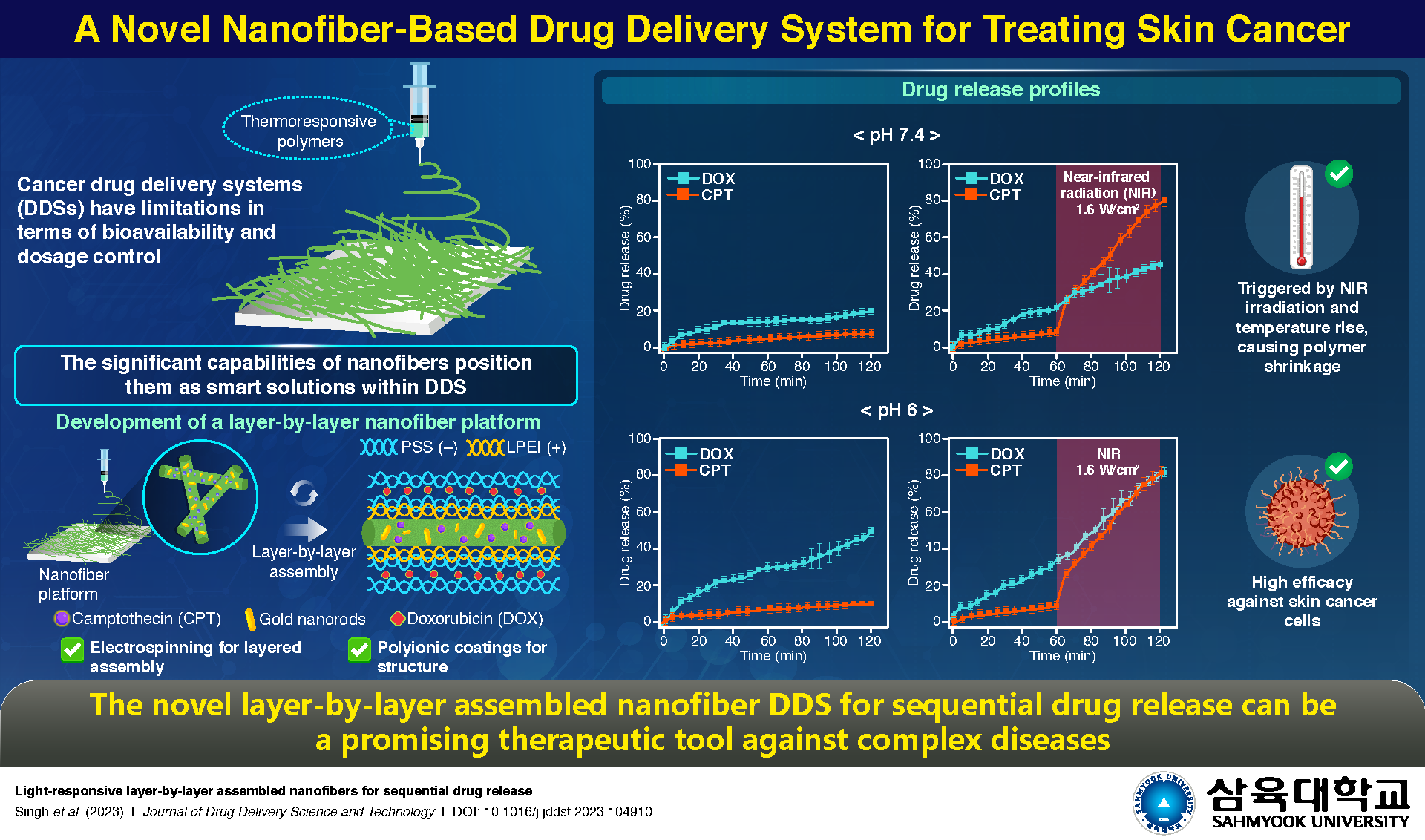Lights, Cancer, Action! Sahmyook University Researchers Develop a Light-Responsive Novel Drug Delivery System Against Skin Cancer
2024-01-18 433
The layer-by-layer assembled nanofibers target skin cancer through a controlled and sequential drug release mechanism.
Nanotechnology-based drug delivery systems (DDS) offer several advantages, such as enhanced bioavailability and controlled drug release with reduced dosage. Recently, Sahmyook University researchers have developed a light-responsive DDS to treat skin cancer. By incorporating gold nanorods into the matrix of nanofibers, the study demonstrates external control over the release of anticancer drugs in a sequential and controlled method. This innovative DDS holds promise for future real-life nanotech-based applications in healthcare.

Treating complex diseases such as skin cancer often requires simultaneous administration of multiple anticancer drugs. The delivery of such life-saving therapeutic drugs has evolved with the rise of nanotechnology-based drug carriers. Nanoplatforms offer numerous advantages, including increased bioavailability, lowered dosages, and improved biodistribution.
In this light, a team of researchers led by Professor Myoung-Hwan Park from Sahmyook University in South Korea has developed a light-responsive nanofiber-based novel drug delivery system (DDS) targeting skin cancer. The DDS was studied in a detailed manner, beginning with its synthesis and characterization to its biocompatibility, drug release profile, and efficacy against skin cancer. These research findings were made available online on 1 September 2023 and was published in Volume 88 of the Journal of Drug Delivery Science and Technology on 1 October 2023.
Explaining the motivation behind the present research, Dr. Park explains, “Conventional drugs can be efficiently delivered in a controlled manner through nano-engineered platforms and such an approach increases the overall effectiveness of the treatment. This approach improves outcomes in cancer drug therapy by ensuring precise delivery at optimal dosages.”
The researchers employed various innovative research methods in developing a smart DDS against skin cancer. Overcoming the solubility barrier of anticancer drugs is crucial and is achieved by coating them with suitable materials for better release. They created camptothecin (CPT)-contained nanofibers (NFs), using electrospinning. The sequential and controlled drug release from NFs was achieved by using a layer-by-layer assembly process involving poly-ionic coatings to load doxorubicin (DOX).
At pH 7.4, DOX was initially released to a lesser extent, and at pH 6, a substantially larger release was noted. To externally control the drug release profile of CPT, gold nanorods (GNRs) were used. Upon near-infrared (NIR) exposure, the GNRs present in the nanofibers facilitated localized heating, which, in turn, triggered the sequential and controlled release of CPT by causing the thermosensitive polymer to shrink and swell.
Envisioning the long-term applications of their work, Dr. Park speculates, “Our nanoplatform show significant potential for real-life practical applications in the form of topical drug products for various skin disorders, such as psoriasis, skin cancer, skin wounds, bacterial and fungal infections. Accordingly, the integration of nanofibers with on-demand drug delivery systems can open up new possibilities for drug therapy.”
Indeed, the development of a multi-stimuli-triggered smart DDS against skin cancer emphasizes the immense potential of nanoplatforms in the advancement of healthcare.
Reference
Title of original paper: Light-responsive layer-by-layer assembled nanofibers for sequential drug release
Journal: Journal of Drug Delivery Science and Technology
DOI: 10.1016/j.jddst.2023.104910
About the institute
Sahmyook University is situated in metropolitan Seoul, South Korea. The university is renowned for its pristine campus, earning the title of "Korea's most beautiful university." Its commitment to environmental sustainability is reflected in its eco-friendly construction. The university prides itself on its unique holistic academic counselling system in which students and professors organically work together in receiving and giving guidance. Comprising six colleges, including the College of Theology, Humanities & Social Science, and Health Science & Social Welfare, as well as four graduate schools, Sahmyook University provides a comprehensive educational experience.
Website: https://www.syu.ac.kr/eng/
About the authors
Myoung-Hwan Park is an Associate Professor of Chemistry and Life Science and Director of Research Center for NanoBioMaterials Lab. at Sahmyook University, Korea. His group is developing novel approaches and versatile materials for applications in drug delivery systems and industrial devices. He is also the founder and current CEO of NtoB Co., Ltd., which develops drug delivery platforms for brain cancer and cosmetics, and NBChem Co., Ltd., which manufactures low-friction coating composites for mobile machines. Before coming to Sahmyook University, he completed the Postdoctoral training at Paula Hammond’s lab at department of chemical engineering of MIT. In 2012, he received his PhD under the supervision of Prof. Vincent Rotello of Chemistry from University of Massachusetts at Amherst.
Nanotechnology-based drug delivery systems (DDS) offer several advantages, such as enhanced bioavailability and controlled drug release with reduced dosage. Recently, Sahmyook University researchers have developed a light-responsive DDS to treat skin cancer. By incorporating gold nanorods into the matrix of nanofibers, the study demonstrates external control over the release of anticancer drugs in a sequential and controlled method. This innovative DDS holds promise for future real-life nanotech-based applications in healthcare.

Treating complex diseases such as skin cancer often requires simultaneous administration of multiple anticancer drugs. The delivery of such life-saving therapeutic drugs has evolved with the rise of nanotechnology-based drug carriers. Nanoplatforms offer numerous advantages, including increased bioavailability, lowered dosages, and improved biodistribution.
In this light, a team of researchers led by Professor Myoung-Hwan Park from Sahmyook University in South Korea has developed a light-responsive nanofiber-based novel drug delivery system (DDS) targeting skin cancer. The DDS was studied in a detailed manner, beginning with its synthesis and characterization to its biocompatibility, drug release profile, and efficacy against skin cancer. These research findings were made available online on 1 September 2023 and was published in Volume 88 of the Journal of Drug Delivery Science and Technology on 1 October 2023.
Explaining the motivation behind the present research, Dr. Park explains, “Conventional drugs can be efficiently delivered in a controlled manner through nano-engineered platforms and such an approach increases the overall effectiveness of the treatment. This approach improves outcomes in cancer drug therapy by ensuring precise delivery at optimal dosages.”
The researchers employed various innovative research methods in developing a smart DDS against skin cancer. Overcoming the solubility barrier of anticancer drugs is crucial and is achieved by coating them with suitable materials for better release. They created camptothecin (CPT)-contained nanofibers (NFs), using electrospinning. The sequential and controlled drug release from NFs was achieved by using a layer-by-layer assembly process involving poly-ionic coatings to load doxorubicin (DOX).
At pH 7.4, DOX was initially released to a lesser extent, and at pH 6, a substantially larger release was noted. To externally control the drug release profile of CPT, gold nanorods (GNRs) were used. Upon near-infrared (NIR) exposure, the GNRs present in the nanofibers facilitated localized heating, which, in turn, triggered the sequential and controlled release of CPT by causing the thermosensitive polymer to shrink and swell.
Envisioning the long-term applications of their work, Dr. Park speculates, “Our nanoplatform show significant potential for real-life practical applications in the form of topical drug products for various skin disorders, such as psoriasis, skin cancer, skin wounds, bacterial and fungal infections. Accordingly, the integration of nanofibers with on-demand drug delivery systems can open up new possibilities for drug therapy.”
Indeed, the development of a multi-stimuli-triggered smart DDS against skin cancer emphasizes the immense potential of nanoplatforms in the advancement of healthcare.
Reference
Title of original paper: Light-responsive layer-by-layer assembled nanofibers for sequential drug release
Journal: Journal of Drug Delivery Science and Technology
DOI: 10.1016/j.jddst.2023.104910
About the institute
Sahmyook University is situated in metropolitan Seoul, South Korea. The university is renowned for its pristine campus, earning the title of "Korea's most beautiful university." Its commitment to environmental sustainability is reflected in its eco-friendly construction. The university prides itself on its unique holistic academic counselling system in which students and professors organically work together in receiving and giving guidance. Comprising six colleges, including the College of Theology, Humanities & Social Science, and Health Science & Social Welfare, as well as four graduate schools, Sahmyook University provides a comprehensive educational experience.
Website: https://www.syu.ac.kr/eng/
About the authors
Myoung-Hwan Park is an Associate Professor of Chemistry and Life Science and Director of Research Center for NanoBioMaterials Lab. at Sahmyook University, Korea. His group is developing novel approaches and versatile materials for applications in drug delivery systems and industrial devices. He is also the founder and current CEO of NtoB Co., Ltd., which develops drug delivery platforms for brain cancer and cosmetics, and NBChem Co., Ltd., which manufactures low-friction coating composites for mobile machines. Before coming to Sahmyook University, he completed the Postdoctoral training at Paula Hammond’s lab at department of chemical engineering of MIT. In 2012, he received his PhD under the supervision of Prof. Vincent Rotello of Chemistry from University of Massachusetts at Amherst.


